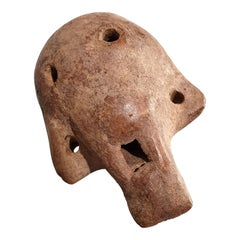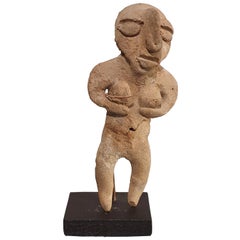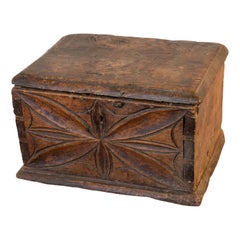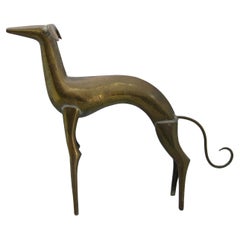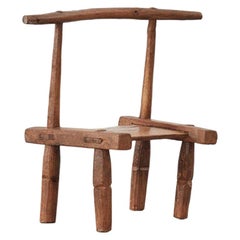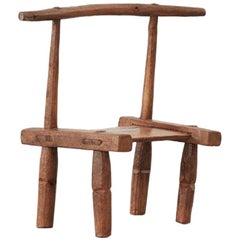London - Primitives
to
2
44
9
2
2
2
2
2
2
2
2
2
Item Ships From: London
Ecuadorian Carved Skull Shaped Whistle
Located in London, GB
This unique and amazing Ecuadorian primitive piece is a whistle carved in a skull form, and dates to the formative stage from the woodland period. It measures 2 in – 5 cm wide, 2 ½ i...
Category
15th Century and Earlier Ecuadorean Antique London - Primitives
Materials
Clay
$794 Sale Price
55% Off
Small Ecuadorian Moulded Clay Figure on Stand
Located in London, GB
This rare and wonderful example of a formative stage figure from the woodland period is attached to a small wire and wood stand, and is in extraordinarily very good condition for its...
Category
15th Century and Earlier Ecuadorean Antique London - Primitives
Materials
Clay
$1,233 Sale Price
50% Off
Related Items
Early 18th Century Italian Carved and Dovetailed Walnut Alms Box
Located in San Francisco, CA
Early 18th century Italian carved and dovetailed walnut alms box, circa 1725
Large dovetails and old handwrought nails give this small scale box a hea...
Category
Early 18th Century Italian Baroque Antique London - Primitives
Materials
Iron
Antique Art Deco Greyhound Whippet Dog Figural Brass Figure Sculpture French?
By Bauhaus
Located in San Diego, CA
Antique Art Deco hollow brass Greyhound/Whippet dog figurine or sculpture circa 1920s-1930s. I am not able to find a signature or makers mark. Probably made in Germany or France. Gre...
Category
Early 20th Century French London - Primitives
Materials
Brass
$800
H 7.75 in W 9.5 in D 1.5 in
Pre Columbian Female Stone Fertility figure Costa Rica
Located in London, GB
Pre Columbian Female Stone Fertility figure Costa Rica
Pre-Columbian, Central America, Costa Rica, Central Highlands, Atlantic Watershed, C. 1000 to 1400 CE.
A carved volcanic stone ...
Category
15th Century and Earlier Costa Rican Antique London - Primitives
Materials
Stone
Antique English Irish Setter Dog Figural Verdigris Bronze Figurine Sculpture
By Jennings Bros.
Located in San Diego, CA
Antique solid bronze with a verdigris finish Irish/English Setter hunting dog figurine or sculpture circa 1930s. I am not able to find a signature or makers mark. Great patina and co...
Category
Early 20th Century French London - Primitives
Materials
Bronze
$325
H 2 in W 5.5 in D 1.5 in
Antique South American Spanish Colonial Folk Art Santos Figure
Located in London, GB
Antique South American Spanish Colonial Poly chrome Folk Art Santos figure The finely sculptured hard wood figure standing with a cross and bible on a pedestal base, painted in p...
Category
18th Century Peruvian Antique London - Primitives
Materials
Gesso, Wood
Vintage Cast Iron Horse Pony Bank Figure
Located in Asheville, NC
Adorable small vintage cast iron horse bank. Good condition.
Category
Mid-20th Century London - Primitives
Materials
Iron
Pre Columbian Inca double chambered whistle vessel South Latin American Antiques
Located in London, GB
Pre Columbian Inca double chambered whistle Vessel Circa 15- 16th Century Ad
A fine Inca greyware vessel double chambered with a bird whistle on ...
Category
15th Century and Earlier Peruvian Antique London - Primitives
Materials
Pottery
$541
H 5.91 in W 8.67 in D 4.73 in
Antique Lion's Head in Polychrome and Cast Iron on Stand
Located in Meer, VAN
Antique Lion's Head in Polychrome and Cast Iron on Stand
Just a wonderful antique lion’s head in heavy cast iron on a later stand. The lion most probably used to be a door ornament ...
Category
19th Century European Antique London - Primitives
Materials
Iron
Pre Columbian Rare Lambayeque Wood Figure
Located in London, GB
Pre columbian Lamabayeque wood figure Peru Circa 750 to 1375 AD
A rare standing figure of a deity with triangular tear drop shaped eyes holding a child,
Carved in very dense heavy hard wood
Measures: Height 14 inches, 36 cm weight, 1.5 kg approx
Ex collection of a Oxford Academic, reputed to have came from Pit rivers...
Category
15th Century and Earlier Peruvian Antique London - Primitives
Materials
Wood
LOVELY PAIR OF ANTIQUE COLLECTABLE VICTORIAN JELLY MOULDS IN COPPEr
Located in West Sussex, Pulborough
We are delighted to offer for sale this collectable pair of Victorian copper Jelly Moulds
A very good looking and decorative pair, they can be used...
Category
19th Century British Victorian Antique London - Primitives
Materials
Copper
$404
H 4.53 in W 7.29 in D 7.29 in
Sterling Silver and Coral Rattle Whistle
Located in Coeur d'Alene, ID
Exceptional antique Victorian sterling silver baby rattle and whistle has a bulbous shaped form. The surface of the tiered body is embellished with impressive embossed leaf decoratio...
Category
1870s English Antique London - Primitives
Materials
Sterling Silver
Antique Carved and Decorated Ship's Figurehead
Located in Sheffield, MA
Antique carved and decorated ship's figurehead, circa 1890, depicting a regal bird with a beak. The sculpture is in original paint. Although there has been much paint loss and age cr...
Category
Early 19th Century Indian Antique London - Primitives
Materials
Wood
Previously Available Items
African Baoulé Chair, Ivory Coast, Mid-20th Century
Located in London, GB
This small chair from the ivory coast has a truly lovely presence. It is hand carved and showcases the typical design elements of a ‘Baoulé’ chair, low seat with a vertical back. Ind...
Category
Mid-20th Century Ivorian Primitive London - Primitives
Materials
Wood
African Baoulé Chair, Ivory Coast, Mid-20th Century
Located in London, GB
This small chair from the ivory coast has a truly lovely presence. It is hand carved and showcases the typical design elements of a ‘Baoulé’ chair, low seat with a vertical back. Ind...
Category
Mid-20th Century Ivorian Primitive London - Primitives
Materials
Wood
Zoomorphic Vessel of a Llama with Black Slip Harness
Located in London, GB
This zoomorphic vessel in the shape of a llama with Black Slip Harness is from the Chancay civilization, dated between 1000 and 1400 AD.
The Chancay ...
Category
15th Century and Earlier Peruvian Antique London - Primitives
Materials
Clay
Collection of Six Carved 'Yoruba' Hardwood Tribal Combs
Located in London, GB
A collection of six carved 'Yoruba' hardwood combs.
The Yoruba People are an ethnic group of Southwestern and North central Nigeria as well as Southern and Central Benin known as th...
Category
Early 20th Century African London - Primitives
Ancient British Iron Age Celtic, Stone Carving of a Human Head
Located in London, GB
An enigmatic late Iron Age stone head sculpture, dating to the 1st century BC - 1st century AD.
This imposing sculpture is of characteristically stylized form, carved with a slit mouth, defined ears and hairline. The life sized head is depicted with an intense, even discordant facial expression. The intentional simplicity and earthiness of the features are hallmarks of the type. The base appears to have been modified during the Roman period as it is inscribed in the Latin Alphabet with the letters LR.
Stone carved heads such as this piece are found throughout the areas of Europe once inhabited by the Celts, they are particularly prevalent in Britain and Ireland.
The head was sacred to the Celts, who believed (as many did throughout antiquity) that it housed the soul. They appear to have had huge significance in Celtic polytheistic practices, it is thought that there may even have been a cult of the human head, possibly revolving around headhunting. Certainly it is clear that the pre-Christian Celts placed an almost totemic value on severed heads. The Roman historian Diodoros Sikulos emphasised their value within Celtic warrior society, asserting that a Celt would not sell the embalmed head of his enemy for any price, claiming that he has no need of gold when he had such an obvious emblem of his courage and skill as a warrior. The heads were kept, carefully preserved in chests, and were removed to be put on display for guests in the warrior’s home. This reverence for the enemy’s severed head is much more than the mere tribal barbarism the Romans took it to be, it was obviously a ritual of both cultic and social significance.
There are a multitude of theories on what stone heads such as this piece are meant to represent, though one leading theory is that they depict dieties from the Celtic Pantheon. Indeed, studies have found that these carvings are often found in the vicinity of ancient religious centres and monuments. Such places formed the centre for local communities celebrating important festivals, usually relating to the seasonal equinoxes. One such festival was samhain, which marked the end of the harvest season and the beginning of the darker half of the year. It was the time when cattle were brought back down from the summer pastures, livestock were slaughtered for the winter and bonfires were lit across the hills. The human head was also important in this festival, as the skulls of ancestors were brought in order to feast with the living. The use of modern day pumpkin lanterns...
Category
18th Century and Earlier English Antique London - Primitives
Diminutive Primitive Dresser
Located in London, GB
A primitive dresser of diminutive proportions, Spanish, probably eighteenth century, the super structure with shaped friezes, on base of simple board...
Category
18th Century and Earlier Spanish Folk Art Antique London - Primitives
Papua New Guinea Paddle
Located in London, GB
Ex-Corby Castle, Cumbria
Category
19th Century Papua New Guinean Antique London - Primitives
Materials
Wood
Recently Viewed
View AllMore Ways To Browse
Cast Iron Cow Door Stop
Antique 19th Century Christening Gown
Primitive Shovel
Vintage Triangle Dinner Bell
Pizzle Whip
Elkington Jug
Emmanuelle Simon
Empire Cherry Chest Of Drawers
English Curio Cabinets
English Delft Charger
Enrico Potz
Equestrian Trophy
Erhard And Sohne
Erhard Sohne
Etruscan Antiquities
Extra Large Yellow Vases
Face Mugs
Faux Bois Plate
